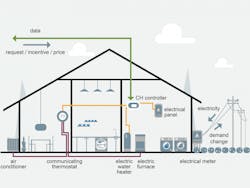Homes Helping the Grid
Article by Tim Ledbetter, PNNL
Researchers at Pacific Northwest National Laboratory (PNNL) have developed a control system that could make most of America’s homes more capable partners in managing the nation’s electricity resources.
The control system effectively transforms existing home heating and cooling units and hot water heaters into smart appliances that can manage their electricity use in ways that help the grid coordinate supply and demand. The system could benefit an estimated 120 million homes.
“From the beginning, our goal has been to develop a solution that’s inexpensive, simple to install and use, and puts residents in charge of its operation,” said PNNL’s Michael Brambley, who leads control system development. “In return for helping the grid, households must receive an incentive, such as a more favorable electricity rate.”
The control system work has been funded by the Department of Energy’s Building Technologies Office (BTO) as part of a connected homes project.
What's a connected home?
A connected home contains smart appliances with communication and control capabilities, which enable the appliances to automatically respond to information from an electric utility. Examples include smart, connected thermostats, which make heating and cooling systems connected, and specially equipped water heaters. Some newer homes already have these types of appliances, but most homes do not.
Experts believe connected homes will play a key role in America’s transition to a decarbonized future energy system, which relies less on traditional non-renewable energy sources and more on clean solar and wind power.
Because solar and wind power are “variable”—that is, their power output ebbs and flows with the rise and fall of the sun and wind—the grid sometimes must quickly pivot to other types of electric generation or manage demand in ways to avoid grid instability and meet electricity needs economically. The generation sources that currently help bridge the gap are, in general, fossil-fuel-fired plants, which increase carbon dioxide emissions and contribute to global climate change.
Connected homes can help address the variable nature of solar and wind energy as well as other conditions on the grid. Home appliances with smart controls that factor in occupant comfort preferences, working in concert with utilities and the grid, can quickly and automatically change their electricity demand to help even out variations and ultimately reduce the amount of greenhouse gases entering the atmosphere.
This “flexible demand” capability, if realized in tens of millions of homes, would give the grid more headroom to coordinate supply and demand at times when clean energy may not be available. Analysis conducted by PNNL and others shows that this flexibility can also reduce costs for both bill payers and utilities.
“Connected homes are becoming increasingly more common, whether by consumer demand or by updated building energy codes,” said Marc Costa, director of policy and planning at The Energy Coalition. Costa served on a BTO peer-review committee that evaluated the progress of PNNL’s control system.
“As customers are trying to save money on their bills, replace major appliances, or are just interested in convenient ways to interact with their homes, there is a major need for objective research in this field. The work of PNNL is critical to understanding the potential impacts and solutions for consumers and for the decentralization of our energy system,” Costa added.
For more information, read the full article on PNNL's website.
